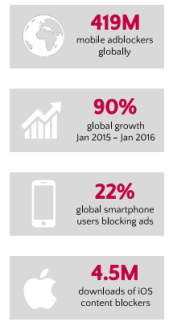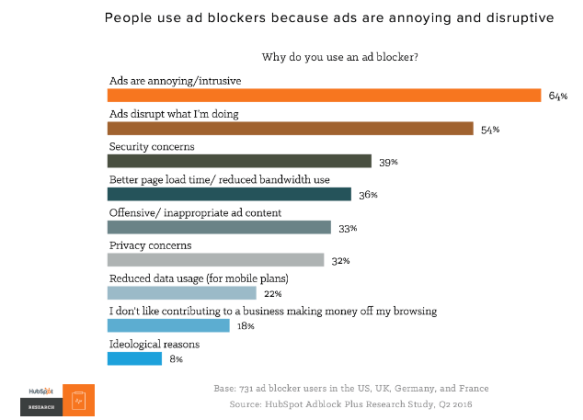August 4, 2016
Banner ads, YouTube pre-roll ads, paid search ads – we’ve seen them all, and most of the time we try to ignore them. Or, if you’re like 45 million other Americans, you have downloaded a software to combat ad blocking entirely. Ad blocking softwares have seen an influx of downloads over the past couple of years. At the end of 2015, the number of people using ad blocking softwares had grown 41% year over year.

Not only has ad blocking grown on desktop and laptop computers, but it’s spread to mobile devices as well. From January 2015 to January 2016, mobile ad blocking saw 90% global growth. On top of that, Apple left ad publishers in the dark when they announced iOS9’s mobile browser would support ad blockers. Essentially, Apple isolated advertisers from millions of iPhone users all around the world – great for consumers, but devastating for ad publishers.
Don’t expect the download of ad blockers to slow down anytime soon. Business Insider reported over “100 million consumers in the U.S. will be ad-block users in 2020.” That’s an increase of over 120% in the next four years!
The Effect of Ad Blocking
Ad blockers have had a nasty effect on the marketing and advertising sphere. In 2015, $ 21.8 billion of ad revenue was lost due to ad blockers. That number will only increase, possibly reaching $ 35 billion by 2020. This puts the digital advertising industry in a difficult position and emphasizes a need for change.
“The online industry, and the publications that rely on it for revenue, are at a watershed point because ad blocking has diminished the impact ads have online.” -Mimi An, HubSpot
Ad blocking isn’t confined to the digital space either. When it comes to the television industry, we’ve seen and probably participated in ad blocking – just in a different form. The introduction of the DVR gave viewers the opportunity to skip ads and get straight to television content. Suddenly advertisers had to rethink their marketing strategies to get their product in front of viewers; one of those strategies was product placement within the television programs. Alas, the emergence of influencer marketing…
Annoying vs. Authentic Advertising
We can all agree there are occasions when digital ads are extremely annoying and intrusive. There are times you want to show a YouTube video to all your friends, but first have to impatiently sit through a 15 or 30 second preroll ad. Or when you are online shopping for new items for your wardrobe, then proudly decide against splurging, only to find the sweater you had your eye on pop up on your Facebook feed the next day.
Forcing ads in front of consumers is not an effective advertising strategy – in fact, 64% of people download ad blockers for this reason alone.

Influencer marketing can combat ad blocking because featured brands and products are incorporated organically into content with authentic, real people. Better yet, this is content people actually want to consume – content people have subscribed, followed or actively sought out because they’re interested in it.
Build Trust and Target Accurately
HubSpot and AdBlock Plus surveyed online browsers to learn their opinions on digital ads and the use of ad blockers. 84% of respondents claimed obnoxious or intrusive digital ads give them a poor opinion of the brands being advertised. They lose trust in the brand and turn to ad blockers to eliminate the intrusive content. Instead, brands can build trust back up by using influencer marketing to defeat those ad blockers and get in front of the right audience.
Content creators want to preserve the trust of their viewers just as much as you want to build the trust of future customers. Content creators also have a reputation to uphold, which makes them great spokespeople – it is unlikely they will promote a brand they truly don’t care about. Since they want to be honest to their viewers, they will be authentic representatives of your brand. Even if a creator identifies a small flaw in the product, providing this information to their viewers is important to maintain trust and educate their audience. These strong and loyal creator-viewer relationships can result in higher conversion rates.
Overcoming Mobile Ad Blocking
Influencer marketing combats ad blocking on desktop and laptop computers, but even more so on mobile devices. More than half of the views on YouTube are from mobile devices – if you add influencer marketing to your budget, then your digital advertising on mobile is not completely lost. And with Instagram predominately being a mobile app (although also available on browsers), the reach to consumers on devices grows even more. No need to be afraid of Apple’s iOS9 ad blocking release when you have influencer marketing to cut them to the chase.

It does not come as a surprise to us that many larger brands are flocking to influencer marketing to beat ad blocking softwares. One example is L’Oreal, who hired multiple social media creators to feature their products in the creators’ content. Not only are they avoiding ad blockers, but they are also reaching new consumers through the creator’s very loyal fan base.
Digital advertising budgets are growing, but with ad blockers diluting the ad content, is the money going to waste? Not with influencer marketing. It is worth the investment, and is definitely a powerful weapon to combat ad blocking softwares.
Originally posted on the Grapevine blog
Digital & Social Articles on Business 2 Community(42)
Report Post




